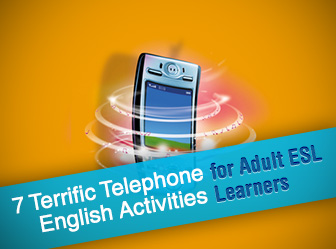Who Called and Said She’s Interested in Our Service?: Teaching the Art of Leaving and Taking Phone Messages


On one hand, listening comprehension proves to be more difficult on the phone. On the other hand, it is sometimes absolutely necessary for those who do not live in English speaking countries to communicate with others in English – and on the phone.
So, for most adult ESL learners, speaking on the telephone in English is an essential skill. Fortunately, it is one that may be improved, if you give your students fun, interactive activities to help them practice. Here are some great ways to practice speaking English on the telephone.

Have students practice leaving each other messages. First, try to gather as many recording devices as you can: MP3 players, digital recorders, laptops with microphones, or even your students’ own cell phones (there’s no need to actually make calls, just use notetaking software like Evernote or any other that may be used to record voice notes on cell phones).
If you have a large class, have groups of two or three students share one device. Have students record their outgoing messages, then students take turns leaving messages for their classmates. This works best if you give each student a specific reason for calling.
Students practice asking the other speaker to repeat or clarify something they did not understand. Divide students into pairs and assign the roles of caller (Student A) and non-native speaker (Student B). Student B pretends they speak very little English so that Student A has to ask B to repeat everything they say. Variations include adding background noise, static, or having Student B speak very softly. You can also give them specific instructions/complications, like a difficult name to spell, or asking for directions.
When conducting some transactions on the phone, we are quite often asked to supply personal details to confirm our identity. Give your students this situation or a very similar one: Student A wants to purchase an item on eBay, but is unable to make the payment. Student B works in Customer Support and will help Student A complete the transaction. But before they can do that, Student B asks Student A a series of personal questions, from address to phone number, ID number to mother’s maiden name. A fun twist is to ask Student B to ask as many questions as he/she can, including ridiculous things, like a pet’s name!
This is a great way to have students practice their reason for calling over and over again. Give Student A a reason to call Customer Support. Student B takes the call, but then connects Student A with another department (Sales, Technical Assistance, Accounts Payable, etc…) Student C then connects A with D and so on. Student A must repeat the reason for calling each and every time.
This works great with beginners who are not yet familiar with common telephoning expressions and their appropriate intonation. Play a telephone conversation while students read and mimic the call as it plays – the goal is to follow the rhythm and copy the intonation to match the speakers in the audio. Play the audio track again, but this time lower the volume, and then a third time with the volume even lower. Play the track as many times as needed, till students are able to act out the situation comfortably without listening or reading.
Write out a complete telephone conversation on the whiteboard. Have students take turns reading it out loud. Then, erase one or a few words, depending on how long the conversation is. Students once again read it out loud and include the missing word(s). Continue erasing words, a few at a time and having students read the conversation, until all of the text has been erased. Students must then say it completely from memory.
Print out role play cards that include a variety of reasons for calling (making/changing appointments, asking for someone on the phone, a problem with a bill/invoice) and proper responses to these situations (“The doctor is available Tuesday morning”; “He’s at a meeting right now. Would you like to leave a message?”; “I’ll put you through to Accounts Payable”). Student A picks up a Reason for Calling card and calls Student B. Student B has to choose the appropriate response from the set of Response cards.
Most telephone conversations are based on a certain repetitive set of phrases for talking on the phone. The more you expose your students to and the more you practice them, the easier it will be for them to handle a variety of telephone situations.
And if you’re on the lookout for more great speaking activities, BusyTeacher has over 100 Role Plays worksheets that you can download and use today!